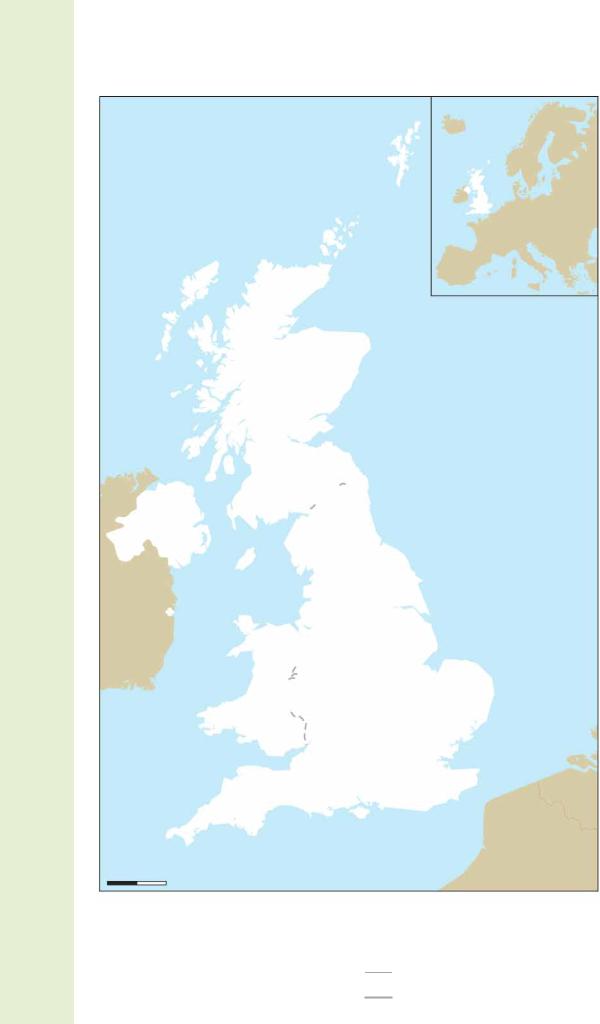
- •Foreword
- •Table of contents
- •Figures
- •Tables
- •Boxes
- •1. Executive summary
- •Energy system transformation
- •Special focus 1: The cost-effectiveness of climate measures
- •Special focus 2: The Electricity Market Reform
- •Special focus 3: Maintaining energy security
- •Key recommendations
- •2. General energy policy
- •Country overview
- •Institutions
- •Supply and demand trends
- •Primary energy supply
- •Energy production
- •Energy consumption
- •Energy policy framework
- •Energy and climate taxes and levies
- •Assessment
- •Recommendations
- •3. Energy and climate change
- •Overview
- •Emissions
- •GHG emissions
- •Projections
- •Institutions
- •Climate change mitigation
- •Emissions targets
- •Clean Growth Strategy
- •The EU Emissions Trading System
- •Low-carbon electricity support schemes
- •Climate Change Levy
- •Coal phase-out
- •Energy efficiency
- •Low-carbon technologies
- •Adaptation to climate change
- •Legal and institutional framework
- •Evaluation of impacts and risks
- •Response measures
- •Assessment
- •Recommendations
- •4. Renewable energy
- •Overview
- •Supply and demand
- •Renewable energy in the TPES
- •Electricity from renewable energy
- •Heat from renewable energy
- •Institutions
- •Policies and measures
- •Targets and objectives
- •Electricity from renewable energy sources
- •Heat from renewable energy
- •Renewable Heat Incentive
- •Renewable energy in transport
- •Assessment
- •Electricity
- •Transport
- •Heat
- •Recommendations
- •5. Energy efficiency
- •Overview
- •Total final energy consumption
- •Energy intensity
- •Overall energy efficiency progress
- •Institutional framework
- •Energy efficiency data and monitoring
- •Regulatory framework
- •Energy Efficiency Directive
- •Other EU directives
- •Energy consumption trends, efficiency, and policies
- •Residential and commercial
- •Buildings
- •Heat
- •Transport
- •Industry
- •Assessment
- •Appliances
- •Buildings and heat
- •Transport
- •Industry and business
- •Public sector
- •Recommendations
- •6. Nuclear
- •Overview
- •New nuclear construction and power market reform
- •UK membership in Euratom and Brexit
- •Waste management and decommissioning
- •Research and development
- •Assessment
- •Recommendations
- •7. Energy technology research, development and demonstration
- •Overview
- •Energy research and development strategy and priorities
- •Institutions
- •Funding on energy
- •Public spending
- •Energy RD&D programmes
- •Private funding and green finance
- •Monitoring and evaluation
- •International collaboration
- •International energy innovation funding
- •Assessment
- •Recommendations
- •8. Electricity
- •Overview
- •Supply and demand
- •Electricity supply and generation
- •Electricity imports
- •Electricity consumption
- •Institutional and regulatory framework
- •Wholesale market design
- •Network regulation
- •Towards a low-carbon electricity sector
- •Carbon price floor
- •Contracts for difference
- •Emissions performance standards
- •A power market for business and consumers
- •Electricity retail market performance
- •Smart grids and meters
- •Supplier switching
- •Consumer engagement and vulnerable consumers
- •Demand response (wholesale and retail)
- •Security of electricity supply
- •Legal framework and institutions
- •Network adequacy
- •Generation adequacy
- •The GB capacity market
- •Short-term electricity security
- •Emergency response reserves
- •Flexibility of the power system
- •Assessment
- •Wholesale electricity markets and decarbonisation
- •Retail electricity markets for consumers and business
- •The transition towards a smart and flexible power system
- •Recommendations
- •Overview
- •Supply and demand
- •Production, import, and export
- •Oil consumption
- •Retail market and prices
- •Infrastructure
- •Refining
- •Pipelines
- •Ports
- •Storage capacity
- •Oil security
- •Stockholding regime
- •Demand restraint
- •Assessment
- •Oil upstream
- •Oil downstream
- •Recommendations
- •10. Natural gas
- •Overview
- •Supply and demand
- •Domestic gas production
- •Natural gas imports and exports
- •Largest gas consumption in heat and power sector
- •Natural gas infrastructure
- •Cross-border connection and gas pipelines
- •Gas storage
- •Liquefied natural gas
- •Policy framework and markets
- •Gas regulation
- •Wholesale gas market
- •Retail gas market
- •Security of gas supply
- •Legal framework
- •Adequacy of gas supply and demand
- •Short-term security and emergency response
- •Supply-side measures
- •Demand-side measures
- •Gas quality
- •Recent supply disruptions
- •Interlinkages of the gas and electricity systems
- •Assessment
- •Recommendations
- •ANNEX A: Organisations visited
- •Review criteria
- •Review team and preparation of the report
- •Organisations visited
- •ANNEX B: Energy balances and key statistical data
- •Footnotes to energy balances and key statistical data
- •ANNEX C: International Energy Agency “Shared Goals”
- •ANNEX D: Glossary and list of abbreviations
- •Acronyms and abbreviations
- •Units of measure

2. General energy policy
Key data
(2017)
TPES: 175.9 Mtoe (natural gas 38.6%, oil 34.5%, nuclear 10.4%, biofuels and waste1 7.1%, coal 5.4%, wind 2.4%, electricity 0.7%, solar 0.6%, hydro 0.3%) -16.7% since 2007
TPES per capita: 2.7 toe/cap (IEA average: 4.1 toe)
TPES per unit of GDP: 68 toe/USD million PPP (IEA average: 105 toe)
TFC: 127.3 Mtoe (oil 43.4%, natural gas 30.1%, electricity 20.3%, biofuels and waste 3.4%, coal 1.7%, heat 1.0%) -10.5% since 2007
Energy production: 120.2 Mtoe (oil 40.2%, natural gas 30.0%, nuclear 15.3%, biofuels and waste 8.2%, wind 3.6%, coal 1.5%, solar 0.9%, hydro 0.4%), -31.8% since 2007
Country overview
The United Kingdom consists of Great Britain (England, Wales, and Scotland) and Northern Ireland with a total area of 244 000 square kilometres (Figure 2.1). The United Kingdom’s population was around 66 million in 2016, an increase of over half a million people since 2014, and is expected to continue to grow as a result of immigration and increased life expectancy. The third-largest economy in Europe after Germany and France, in 2018, the United Kingdom’s gross domestic product (GDP) was USD 3 trillion and its annual GDP growth rate was 1.3% (OECD, 2019).
The United Kingdom is a parliamentary democracy with a monarchy under Her Majesty Queen Elizabeth II. The legislative power is vested in the two chambers of the parliament
– the House of Commons and the House of Lords – and the judiciary is independent of the executive and the legislature. Her Majesty’s government (HMG) is the central government of the United Kingdom and the current head of HMG is the Prime Minister Theresa May of the Conservative Party. The centre-right conservative government failed to obtain the majority after the election in June 2017 and is governing with a hung parliament. The United Kingdom has devolved powers to the Scottish government, Welsh government, and Northern Ireland Executive. The United Kingdom has been a member of the European Union (EU) since its accession in 1973, but it remained outside the Economic and Monetary Union with its own currency.
1 Biofuels and waste in this report mean solid and liquid biofuels, biogases, industrial waste and municipal waste.
17
ENERGY INSIGHTS
IEA. All rights reserved.

2. GENERAL ENERGY POLICY
Figure 2.1 Map of the United Kingdom
SCOTLAND
|
|
• |
|
•Edinburgh |
|
||
|
|
Glasgow |
|
|
., |
|
|
|
|
|
|
|
|
|
|
|
|
|
|
|
\ |
|
|
|
|
NORTHERN |
|
\ |
< |
. |
|
|
|
|
|
|
|
|
|
|
|
IRELAND |
|
|
Newcastle |
|
|
|
|
Belfast • |
|
|
|
||
|
|
|
|
|
|
|
|
|
IRELAND |
|
|
|
|
|
|
|
|
|
|
|
Manchester |
|
|
|
Dublin @ |
|
' |
• |
|
|
|
|
|
|
, •Liverpool |
|
|
||
|
|
|
( |
_.., |
|
ENGLAND |
|
|
|
|
.... |
|
|||
|
|
|
', |
• Birmingham |
|||
|
|
WALES |
1r |
|
|
|
|
|
|
|
|
• |
|
|
London@ |
|
|
|
Bristol |
|
|||
|
|
|
|
|
|||
|
|
Plymouth |
|
|
|
|
BELGIUM |
|
|
• |
|
|
|
|
|
|
km |
|
|
|
|
|
FRANCE |
0 |
50 |
100 |
|
|
|
|
|
This map is without prejudice to the status of or sovereignty over any territory, to the delimitation of international frontiers and boundanes and to the name of any terntory, city or area.
Note: km = kilometre.
18
IEA. All rights reserved.

2. GENERAL ENERGY POLICY
In June 2016, former Prime Minister David Cameron initiated a referendum on the EU membership, which saw a public decision to leave the EU (or Brexit). Uncertainty remains over the format and timing of Brexit in 2019 (with or without the withdrawal agreement (UK Government 2018a) as well as the future relationship with the EU (UK Government, 2018b and 2018c).
Institutions
The central government of the United Kingdom leads the overall energy policy strategy. Administrative, executive, or legislative authority is transferred to the so-called devolved administrations, which were created for Scotland, Northern Ireland, and Wales. Much of energy policy is reserved to the UK Parliament, notably European Union and international energy relations, competition, consumer protection, and transport. Devolved administrations have to act in areas where they have either exclusive or shared competence, such as the consent of small-scale generation, climate change, or energy efficiency, as outlined below.
Table 2.1 Devolved administration
Energy policy area |
Wales |
Scotland |
Northern Ireland |
|
|
|
|
Climate change mitigation |
√ |
√ |
√ |
|
|
|
|
Company law |
X |
X |
√ |
|
|
|
|
Consumer Protection |
X |
X |
√ |
|
|
|
|
Consumer advice and advocacy |
X |
√ |
√ |
|
|
|
|
Competition policy |
X |
X |
= |
|
|
|
|
Economic development |
√ |
√ |
√ |
|
|
|
|
Energy efficiency by prohibition or regulation |
X |
X |
√ |
|
|
|
|
Energy efficiency other than by prohibition or |
√ |
√ |
√ |
regulation |
|
|
|
Energy generation consent |
√ |
√ |
√ |
(large scale – 50 MW up to 350 MW) |
|
|
|
Energy Generation consent |
√ |
√ |
√ |
(small scale – under 50 MW) |
|
|
|
Energy policy |
X |
X |
√ |
|
|
|
|
Enterprise and financial assistance to industry |
√ |
√ |
√ |
(concurrent powers) |
|
|
|
European Union and international affairs |
X |
X |
X |
Note: MW = megawatt.
Energy in the United Kingdom is also governed by EU law. The regulatory and policy framework that govern the Great Britain (GB) energy markets are set out in UK legislation and in licences that are granted by the Office of Gas and Electricity Markets (Ofgem) to energy market participants, as well as in industry codes and detailed multilateral industry agreements.
The Department for Business, Energy and Industrial Strategy (BEIS) takes the main responsibility for ensuring the United Kingdom’s secure, clean, and affordable energy supplies and promotes international action on energy security, climate change, and technology innovation. BEIS was created in July 2016 as a result of a
19
ENERGY INSIGHTS
IEA. All rights reserved.

2. GENERAL ENERGY POLICY
merger between the Department of Energy and Climate Change and the Department for Business, Innovation and Skills.
Several companies are under the authority of the BEIS Secretary of State to deliver policy objectives. The Low Carbon Contracts Company and the Electricity Settlements Company are both private limited companies to deliver on the decarbonisation of the UK electricity sector.
The Oil and Gas Authority (OGA) regulates and promotes the UK oil and gas industry to maximise the economic recovery of offshore oil and gas resources. It is in charge of the licensing of oil and gas exploration and development in England and on the UK continental shelf and it promotes investment along the oil and gas supply chain. In 2016, the OGA became a government company with the BEIS Secretary of State as the sole shareholder.
Her Majesty’s Treasury (HMT) sets the direction of the United Kingdom’s economic policy to achieve strong and sustainable growth and controls over public spending. The Department for Environment, Food and Rural Affairs (Defra) is the government department responsible for policy and regulations on environmental, food, and rural issues, which include the domestic adaptation to climate change. Defra works with BEIS to ensure specific government policies on low-carbon energy and decarbonisation measures are sustainable and aligned with Defra’s environmental objectives.
The Ministry of Housing, Communities and Local Government (housing) and the Department for Transport (DFT) co-operate with BEIS on sectoral policies and measures. The Office for Low Emission Vehicles (OLEV) is a joint unit between BEIS and the Department for Transport that supports the early market for ultra-low emission vehicles (ULEVs).
The Office of Gas and Electricity Markets (Ofgem) is the main regulator of the UK gas and electricity networks. Its central role is to protect the consumer interests, which include reducing greenhouse gas (GHG) emissions, ensuring the security of supply, and regulating competitive markets in gas and electricity supply and retail. Ofgem is independent of the government and accountable to the UK Parliament. Ofgem is governed by the Gas and Electricity Markets Authority and funded by annual licence fees paid by licenced companies.
The Competition and Markets Authority (CMA) is the United Kingdom’s primary competition and consumer authority. It is an independent non-ministerial government department with responsibility for carrying out investigations into mergers, markets, and the regulated industries and enforcing competition law. During 2014-16, CMA investigated the supply and acquisition of energy in the United Kingdom and published a report (CMA, 2016) on energy market reform, which set out a wide range of measures to modernise the UK energy market.
The Nuclear Decommissioning Authority is a non-departmental public body that owns 17 civil nuclear legacy sites across the United Kingdom, plus the associated liabilities and assets. The Office for Nuclear Regulation is the United Kingdom’s independent nuclear regulatory authority, set up by the Energy Act 2013 to regulate nuclear safety, security, and conventional health and safety at licensed nuclear sites.
20
IEA. All rights reserved.
